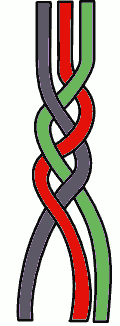How To Make Leather Rope
Making leather string/rope/cordage is easy, assuming you have the leather. If you need to know how to make leather then look here first. Leather
There is more than one way to turn a piece of leather into useful cordage. The simplest method is to simply take a piece of leather and then cut a single strip of leather from it. Leather is flexible and a 12 inch by 12 inch piece of leather can yield a string that is 1/4 of an inch wide and a bit less about 40 feet long. This is accomplished by cutting the square piece of leather spiral pattern. Start at the outside edge and cut along the edge of the leather in either a clockwise or counter-clockwise manner until you reach the center.
This is the simplest method which requires no braiding. It works great for small jobs. I would round out the edges first so that you aren't making any 90 degree cuts. This will strengthen the leather string so that it doesn't have any weak spots. Doing a simple 90 degree cut will result in a weaker cordage because the inside edge will endure most of the force applied before the outside edge starts bearing much of the force.
By braiding three leather strings together as shown in the picture you can make a stronger rope. The braiding process will shorten the strings, so keep this in mind if you need a 10 foot rope. Three 10 foot strands will not yield a 10 foot rope. Start by tying the three leather strings together at one end.
 We will reference the three strands as left, center, and right. This naming will NOT reference their starting position but instead their current position. So a strand that starts off being the center will soon be called the left strand.
We will reference the three strands as left, center, and right. This naming will NOT reference their starting position but instead their current position. So a strand that starts off being the center will soon be called the left strand.
Let's start. Pass the left strand over the center strand. These two strands should now have switch places so that the left becomes the center and vice versa.
Take the right strand and move it over the center strand. Now the right and center strand will have switched places.
Alternate moving the left and right strands. Always cross them over the center strand. Repeat the process until you near the end of the individual strands. Then, tie off the ends.
There is more than one way to turn a piece of leather into useful cordage. The simplest method is to simply take a piece of leather and then cut a single strip of leather from it. Leather is flexible and a 12 inch by 12 inch piece of leather can yield a string that is 1/4 of an inch wide and a bit less about 40 feet long. This is accomplished by cutting the square piece of leather spiral pattern. Start at the outside edge and cut along the edge of the leather in either a clockwise or counter-clockwise manner until you reach the center.
This is the simplest method which requires no braiding. It works great for small jobs. I would round out the edges first so that you aren't making any 90 degree cuts. This will strengthen the leather string so that it doesn't have any weak spots. Doing a simple 90 degree cut will result in a weaker cordage because the inside edge will endure most of the force applied before the outside edge starts bearing much of the force.
By braiding three leather strings together as shown in the picture you can make a stronger rope. The braiding process will shorten the strings, so keep this in mind if you need a 10 foot rope. Three 10 foot strands will not yield a 10 foot rope. Start by tying the three leather strings together at one end.

Let's start. Pass the left strand over the center strand. These two strands should now have switch places so that the left becomes the center and vice versa.
Take the right strand and move it over the center strand. Now the right and center strand will have switched places.
Alternate moving the left and right strands. Always cross them over the center strand. Repeat the process until you near the end of the individual strands. Then, tie off the ends.

